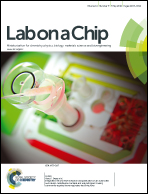Research highlights: printing the future of microfabrication
Abstract
In this issue we highlight emerging microfabrication approaches suitable for microfluidic systems with a focus on “additive manufacturing” processes (i.e. printing). In parallel with the now-wider availability of low cost consumer-grade 3D printers (as evidenced by at least three brands of 3D printers for sale in a recent visit to an electronics store in Akihabara, Tokyo), commercial-grade 3D printers are ramping to higher and higher resolution with new capabilities, such as printing of multiple materials of different transparency, and with different mechanical and electrical properties. We highlight new work showing that 3D printing (stereolithography approaches in particular) has now risen as a viable technology to print whole microfluidic devices. Printing on 2D surfaces such as paper is an everyday experience, and has been used widely in analytical chemistry for printing conductive materials on paper strips for glucose and other electrochemical sensors. We highlight recent work using electrodes printed on paper for digital microfluidic droplet actuation. Finally, we highlight recent work in which printing of membrane-bound droplets that interconnect through bilayer membranes may open up an entirely new approach to microfluidic manufacturing of soft devices that mimic physiological systems.


 Please wait while we load your content...
Please wait while we load your content...